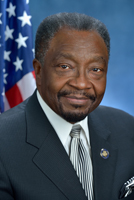
Upset at the prospect of camera-enforced bus lanes on Utica Avenue, which carries more bus passengers than all but a few other streets in New York, Assembly Member N. Nick Perry introduced a bill in Albany this session that would have rendered every bus lane in the city next to useless during midday hours. The bill picked up a sponsor in the State Senate majority -- Brooklyn Republican Marty Golden, who later withdrew the bill, preventing a vote.
New York has the nation's slowest buses, but NYC DOT and the MTA have started to tackle the problem in recent years by rolling out Select Bus Service routes that feature dedicated bus lanes. With less car congestion and double parking blocking the right of way, the lanes make bus travel faster and more reliable. Together with improvements like off-board fare collection, bus lanes have improved travel times for passengers in the range of 15 to 30 percent.
The newest camera-enforced bus lane is on Utica Avenue in Perry's East Flatbush district. Brooklyn's busiest bus route, the B46, runs on Utica and carries 44,000 passengers each weekday. SBS launched there last week, making the B46 the tenth SBS route with bus lanes or bus-only segments. Several older bus lane segments on major avenues are also eligible for camera enforcement.
All of these bus lanes could have been compromised by Perry's bill, introduced in April, to let drivers travel in bus lanes between 10 a.m. and 4 p.m. if they stay at least 250 feet away from buses. Text accompanying the bill argued that "bus lane violations serve as a trap for tickets and summons by the police."
In practice, the bill would render bus lanes unenforceable during the middle of the day, when ridership remains high and service is frequent on busy bus routes. On the B46, for instance, buses run every 5-6 minutes from 10 a.m. to 4 p.m.
Golden introduced a companion bill in the State Senate in May but then withdrew it from consideration the following month.
Perry claimed his bill would make bus lanes "more efficient." "If [drivers] see a bus approaching behind them, they should safely exit the bus lane," he said. "But when there are no buses using the bus lane, we should not waste [road space].
But that scenario highlights why the bill would not work for either cars or buses -- the constant merging by drivers in and out of the bus lane would slow down both motorists and bus passengers.
Perry held that bus lane enforcement is "intended to make money for the city" and framed his bill as an effort to address "neighborhood concerns" in his district and prevent putting "commuters in an adversarial position with residents."
East Flatbush residents, however, are "the commuters" on the B46. About half the households in Perry's district don't own cars, and 61 percent of workers along the B46 route get to work on transit, according to DOT and the MTA. At the same time, the neighborhoods Perry represents are among the densest in the city without convenient subway access -- that's why no bus route in Brooklyn has more riders than the B46.
Faster bus service for those 44,000 passengers is not Perry's priority. While his bill did not pass this legislative session, Perry is still trying to water down the bus lanes on Utica Avenue. He has asked DOT to consider peak-only enforcement and to allow commercial vehicles to park in the bus lane mid-day.

Perry says merchants have complained to him about delivery access with the bus lanes. In response, DOT said it added commercial loading zones on Utica.
During the planning process, DOT and the MTA scaled back bus lane enforcement on Utica from 24 hours per day to weekdays from 7 a.m. to 7 p.m., but the agencies have not compromised service further in response to pressure from Perry. When B46 SBS debuted, the bus lane hours and extent of the bus lanes -- between St. John's Place and Fillmore Avenue -- matched the project description in public presentations going back to last year.
DOT sent the following statement regarding Perry's bill.
DOT and the NYPD both opposed Assembly Member Perry’s bill and think it would be a step back for bus riders in New York City, as it would undermine SBS’ underlying goal of ensuring that the majority of people who travel Utica Avenue by bus -- 44,000 per day -- keep moving. Simply put, it would be difficult and potentially dangerous for drivers to try to judge their distance from buses in front or behind them.
DOT has been committed to a thorough public engagement around SBS. DOT and NYCT conducted extensive outreach and worked closely with the community and local officials in planning this route, including holding over 25 meetings, open houses and workshops. As a result of this outreach and collaboration, we have created commercial loading zones along Utica Avenue to accommodate deliveries and have limited bus-lane hours to be only 7am-7pm to parallel the bus-lane restrictions along the nearby B44 Nostrand Avenue SBS corridor.
Regarding enforcement, a 60-day warning period to motorists began last week following the July 3rd launch. Motorists will not receive camera violations during that period, which will end approximately September 6.
When done properly, organizing busy streets with bus lanes can be a win-win, improving bus travel times without causing slowdowns or diversions of other traffic, and at the same time increasing the safety of busy streets like Utica, which is a Vision Zero priority corridor based on past crash data.






